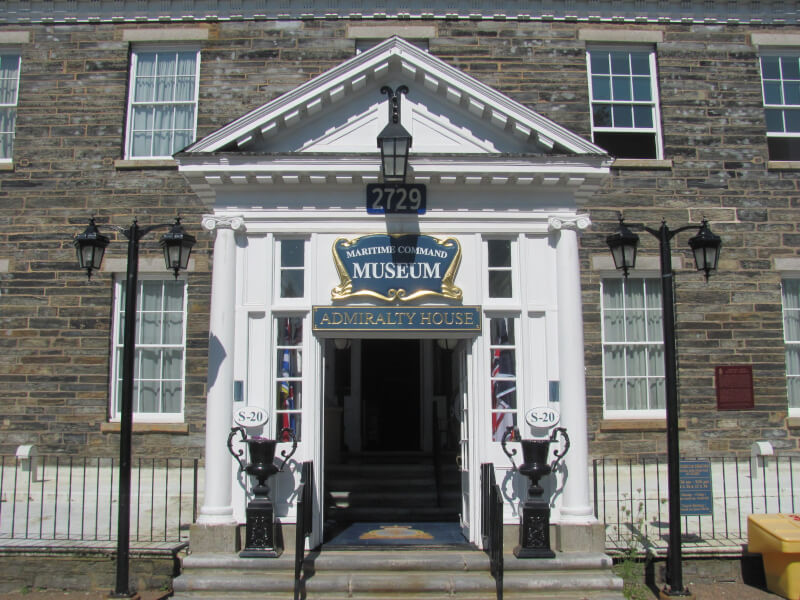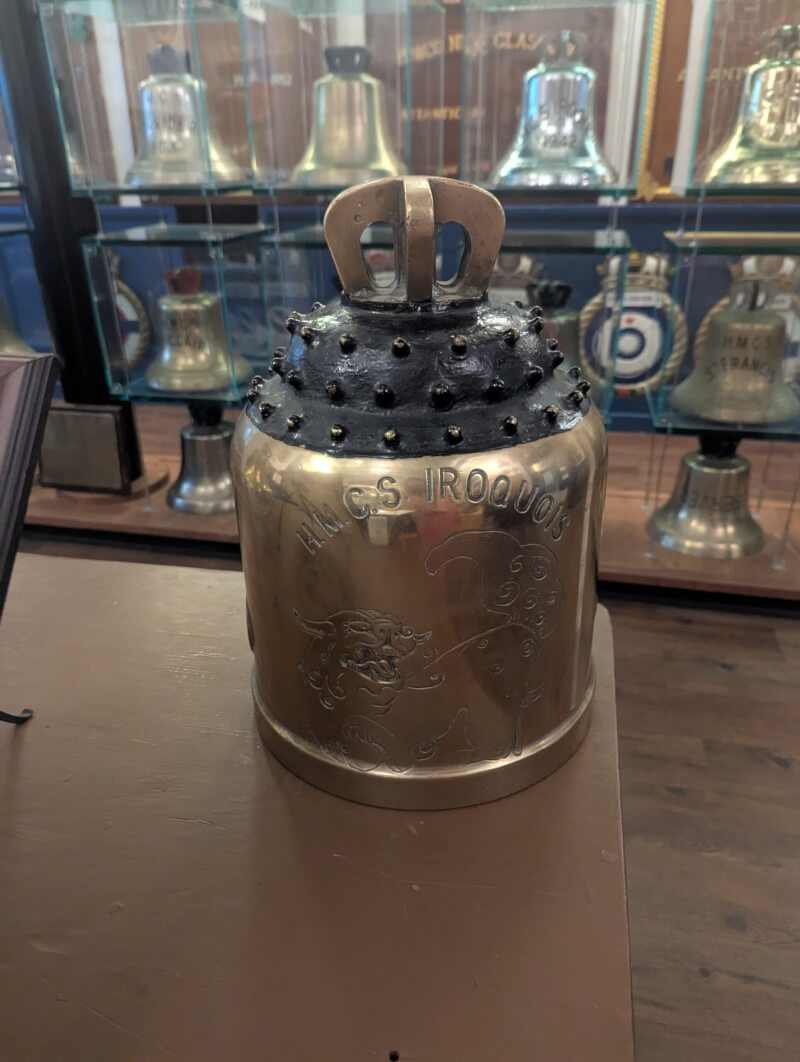
Admiralty House served a plethora of military purposes over the years. Today, it’s home to the Naval Museum of Halifax. [Dan Conlin/Wikimedia]
The Naval Museum of Halifax is a story unto itself. It’s a tale that arguably begins in 1818, upon completion of the Georgian-style structure as part of the city’s renowned dockyard. Rather than a home for artifacts at the time, however, it was the official summer residence for the admiral of the Royal Navy’s North American Station. Not until after 1904, when the Brits ceded the area’s defence, did these grand stone walls become distinctly Canadian.
Admiralty House, as it’s still known today, served a plethora of purposes over the succeeding years, from accommodating Massachusetts relief workers following the 1917 Halifax Explosion—having itself been damaged in the blast—to an officers’ mess amid the Battle of the Atlantic. It has operated as a museum since 1974, nestled within the confines of Canadian Forces Base Halifax (HMCS Stadacona).
“If the walls could talk,” suggested the site’s director Jennifer Denty, “the stories they’d tell.” Here, the naval historian and museum custodian offers them a voice.
About working at the museum
First arriving here felt like coming home. Initially, I did a few casual contracts here as a cataloguer, so I’ve had boots on the ground at the museum since about 2009, when I first came to Halifax. It’s such a cool organization with such a cool history—and I’m now proud to be its director. I have a deep amount of respect for anybody who operates a museum in a heritage house, because they come with all kinds of quirks, but there is also so much value in the infrastructure itself. That said, things like trying to plan visitor flow, say, or organizing an exhibit when you’ve got less than 300 square feet to work with can occasionally be a challenge—while also presenting an opportunity to get creative.
About popular museum exhibits
Many of our exhibits highlight human stories. Of course, there is definitely a place for statistics. It’s important to know the gross tonnage of a ship, the calibre of a rifle, and that ships are the heart and soul of the navy, but it’s also important that we recognize the people who serve aboard these vessels, who give their best and all—at times sacrificing everything for the cause. That’s what we try to do here, not least in our Battle of the Atlantic exhibit on the top floor, exploring the longest continuing battle of the Second World War, where we went from roughly 3,500 people in [naval] uniform [at the start of the war] to about 95,000 people in uniform [at the conflict’s end]. Canada also had the third-largest navy in the world by the end of the Battle of the Atlantic, by which point we’d also had the only theatre of operations entirely commanded by a Canadian [Rear Admiral Leonard W. Murray of Canadian Northwest Atlantic Command]. It’s our golden era in so many ways.
You’re not just looking at a timeline, but the people involved. We have some great artifacts in there, such as a prisoner-of-war jacket from a [German] submariner on U-210 given to somebody aboard HMCS Assiniboine in thanks for kind treatment.
I think our uniform exhibit is another very neat exploration. We had to make some concessions in physical design due to COVID-19, but it’s designed to look like a dressing room because it’s physically in the space that would have likely been a dressing room for an admiral in residence. What’s very cool about it is that it looks at the Canadianization of the Royal Canadian Navy. When the navy was established in 1910, it took on the British model for various reasons. It remained largely British in culture until the Second World War, when a unique Canadian identity emerged. You can see that emergence through these uniforms.
One of my favourite pieces is a naval division beachhead commando uniform. The navy actually had personnel who landed on the beaches of Normandy, tasked with maintaining order during the landings. Word on the street is that these were some of the saltiest and crustiest old sailors the Royal Canadian Navy had in the ranks.
We also get a lot of visitors to our bell room, which is one of the larger collections of bells from commissioned vessels that have been paid off in Canada. It’s in the basement because we have a literal ton of brass in there, but what I find interesting is that if you were serving aboard one of these ships, especially one of the bigger ones, you were entitled to have your children christened on board. And if they were christened on board, their names would then be inscribed on the bell. The bell is the heart and soul of a ship, without question.

The “Sasebo Bell” from HMCS Iroquois, cast in 1952 in Sasebo, Japan, is among the museum’s large collection of ship’s bells. [Naval Museum of Halifax Collection]
About special exhibits
We also do temporary exhibitions, some of them tied to specific events and others showcasing rarely seen objects held in our collection. So, for instance, our newest temporary exhibit features content from our permanent art collection that is usually in storage and seldom displayed. This is a gallery-style exhibit exploring the essential role of naval art in preserving maritime heritage.
Previously, we’ve had a temporary exhibit on Camp Norway [a WW II Norwegian military base in Lunenburg, N.S.] and the Norwegian experience in Nova Scotia in that period. We also had one exploring the centennial of the Royal Canadian Naval Reserve [in 2023] and one smaller exhibit remembering the 50th anniversary of the HMCS Kootenay explosion [in 2019], along with a few of its lasting implications.
About the museum’s future
We now have a strategic plan in place that is guiding us through the development of our organization. We’re aware, for example, that we’re great at telling the big-ticket item stories, but there are certain ones we could touch on more, like the Korean War. So, we’ve been looking at what people come to see, what they want to see, and the stories we tell or don’t tell well—as well as what we have space for.
Next year [2026], will be the first phase of our permanent exhibit rejig. We hope that in roughly the next 10-year period, you’ll see a full replacement of displays.
We’re very fortunate to have an amazing team. But we’re also aware we’re quite small. We must be mindful that while we might have grand visions, burnout is a real thing. So, we’re very much focused on slow growth that is sustainable over time and keeps us moving forward. Yes, admittedly, it might limit what we can achieve over a year, but we’re still really excited about it all coming to fruition.
This abridged interview has been edited for brevity and clarity.
Advertisement
Related posts:
Combat videographer Alison MacLean talks new WW II documentary Op Faust: Hunger Winter ’45
Canadian naval historian speaks out about retrieving shipwreck artifacts
Humanizing the enemy: author shines new perspectives on 1945 bombing of Japan
Historian David O’Keefe on a suspicious WW II aircrew loss






















